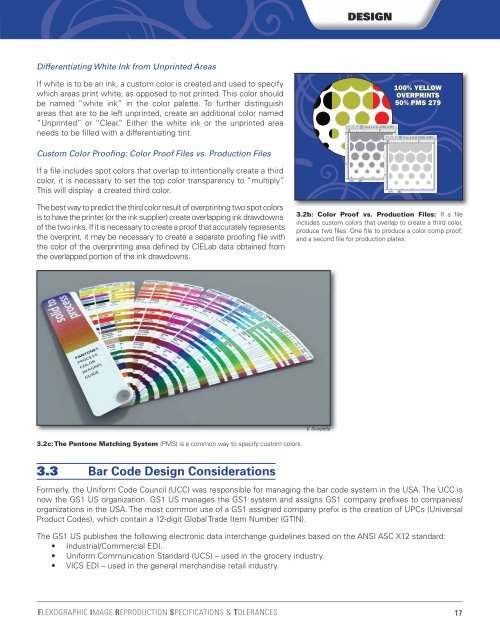First Design Guide - Flexographic Technical Association
First Design Guide - Flexographic Technical Association
First Design Guide - Flexographic Technical Association
You also want an ePaper? Increase the reach of your titles
YUMPU automatically turns print PDFs into web optimized ePapers that Google loves.
Differentiating White Ink from Unprinted Areas<br />
If white is to be an ink, a custom color is created and used to specify<br />
which areas print white, as opposed to not printed. This color should<br />
be named “white ink” in the color palette. To further distinguish<br />
areas that are to be left unprinted, create an additional color named<br />
“Unprinted” or “Clear.” Either the white ink or the unprinted area<br />
needs to be filled with a differentiating tint.<br />
Custom Color Proofing: Color Proof Files vs. Production Files<br />
If a file includes spot colors that overlap to intentionally create a third<br />
color, it is necessary to set the top color transparency to “multiply”.<br />
This will display a created third color.<br />
The best way to predict the third color result of overprinting two spot colors<br />
is to have the printer (or the ink supplier) create overlapping ink drawdowns<br />
of the two inks. If it is necessary to create a proof that accurately represents<br />
the overprint, it may be necessary to create a separate proofing file with<br />
the color of the overprinting area defined by CIELab data obtained from<br />
the overlapped portion of the ink drawdowns.<br />
3.2c: The Pantone Matching System (PMS) is a common way to specify custom colors.<br />
3.3 Bar Code <strong>Design</strong> Considerations<br />
FLEXOGRAPHIC IMAGE REPRODUCTION SPECIFICATIONS & TOLERANCES<br />
100% YELLOW<br />
OVERPRINTS<br />
50% PMS 279<br />
3.2b: Color Proof vs. Production Files: If a file<br />
includes custom colors that overlap to create a third color,<br />
produce two files: One file to produce a color comp proof;<br />
and a second file for production plates.<br />
E. Scarpetta<br />
DESIGN<br />
Formerly, the Uniform Code Council (UCC) was responsible for managing the bar code system in the USA. The UCC is<br />
now the GS1 US organization. GS1 US manages the GS1 system and assigns GS1 company prefixes to companies/<br />
organizations in the USA. The most common use of a GS1 assigned company prefix is the creation of UPCs (Universal<br />
Product Codes), which contain a 12-digit Global Trade Item Number (GTIN).<br />
The GS1 US publishes the following electronic data interchange guidelines based on the ANSI ASC X12 standard:<br />
Industrial/Commercial EDI.<br />
Uniform Communication Standard (UCS) – used in the grocery industry.<br />
VICS EDI – used in the general merchandise retail industry.<br />
17


